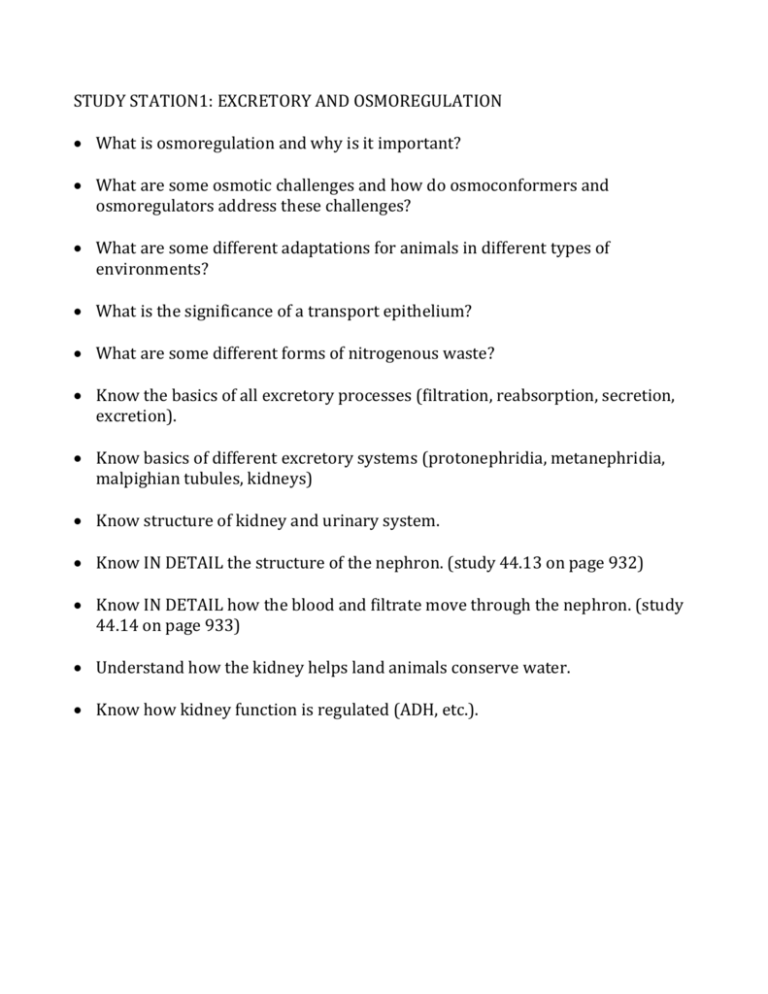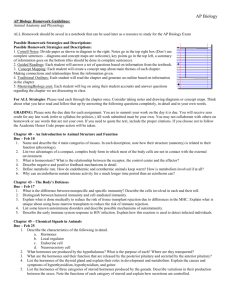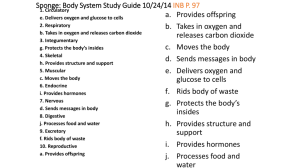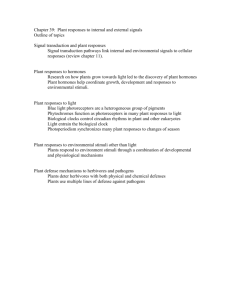STUDY STATION1: EXCRETORY AND OSMOREGULATION What
advertisement

STUDY STATION1: EXCRETORY AND OSMOREGULATION What is osmoregulation and why is it important? What are some osmotic challenges and how do osmoconformers and osmoregulators address these challenges? What are some different adaptations for animals in different types of environments? What is the significance of a transport epithelium? What are some different forms of nitrogenous waste? Know the basics of all excretory processes (filtration, reabsorption, secretion, excretion). Know basics of different excretory systems (protonephridia, metanephridia, malpighian tubules, kidneys) Know structure of kidney and urinary system. Know IN DETAIL the structure of the nephron. (study 44.13 on page 932) Know IN DETAIL how the blood and filtrate move through the nephron. (study 44.14 on page 933) Understand how the kidney helps land animals conserve water. Know how kidney function is regulated (ADH, etc.). STUDY STATION 2: ENDOCRINE SYSTEM What is a hormone? How do the endocrine and nervous system work together? Study feedback loops involved. How do hormones and chemical signals lead to specific cell responses? Understand how cell-surface and intracellular receptors work. Study page 949 and be familiar with glands, the hormones they produce, the type of hormones, the actions of the hormones and how they are regulated. Study relationship between hypothalamus and pituitary, posterior and anterior pituitary hormones (including tropic hormones, nontropic hormones, and growth hormones). Study roles and details of thyroid hormones. Know how parathyroid hormone and calcitonin control blood calcium and how insulin and glucagon control blood (pages 954 – 955). Study details of adrenal hormones and how they respond to stress Know the different types of gonadal sex hormones. How is melatonin involved in biorhythms? STUDY STATION 3: REPRODUCTIVE SYSTEM What are benefits of sexual and asexual reproduction? What are some methods of asexual reproduction? Understand and be able to explain some different reproductive cycles and patterns including parthenogenesis and hermaphroditisim. What is fertilization, what is involved and what are some different means of fertilization? Know details of the male and female reproductive anatomy. Know details and similarities and differences between oogenesis and spermatogenesis. Know how hormones are involved in gametogenesis and how hormones are involved in the ovarian and uterine cycle and the male reproductive system. Study details pregnancy progresses in humans and how hormones are involved at each stage. STUDY STATION 4: DEVELOPMENT How are cytoplasmic determinants involved in animal development? What is cell differentiation and morphogenesis and how are they involved in animal development? Be able to describe the acrosomal reaction and explain its significance. Be able to describe the cortical reaction and explain its significance. How are these involved in mammals? How is the egg activated? Know order of stages: zygote, morula, blastocyst, gastrulation, etc. and what happens in each stage. Explain why animals with a lot of yolk have meriblastic and not holoblastic cleavage. What is gastrulation and what happens with gastrulation? What layers are formed through gastrulation and what body parts do these layers become? Know basics of organogenesis. What is the notochord and how does the neural tube develop? What types of animals are amniotes and what is the significance of extraembryonic membranes? Study basics of morphogenesis, developmental fates, etc. STUDY STATION 5: NERVOUS SYSTEM Know different types of nervous systems What is the CNS and the PNS? How are they both involved in information processing? What are sensory neurons, motor neurons, interneurons, and effector cells and how are they working together? Know the structure of a neuron and be able to recognize the structure of different types of neurons and purpose of different types of glial cells. How is the resting potential of a neuron maintained and how is the membrane potential involved? Know details on how action potentials are produced (study picture on page 1019) and why they are considered to be all or nothing. Know how action potentials are conducted and what salutatory conduction means. Know how neurons communicate with other cells in DETAIL: understand difference between direct synaptic and indirect synaptic transmission, difference between IPSPs and EPSPs and importance of spatial and temporal summation. Review basics of neurotransmitters. Know basic organization of nervous system (study 48.21) Study organization and development of the brain. Know functions attributed to different structures in the brain: including cerebrum, cerebellum, brainstem, corpus callosum, etc. Know basics of information processing, lateralization, language and speech, memory and learning and emotions. Review CNS injuries and disease. STUDY STATION 6: SENSES AND MOVEMENT Study basic process of sensory receptors and how they transmit information including: transduction, amplification, transmission and integration. Know different types of sensory receptors and how they are involved in different sense organs. Understand role of mechanoreceptors in hearing. Know structure of the ear. How does hearing and equilibrium occur in mammals and other vertebrates? How is taste picked up in humans and how are chemoreceptors involved? How are chemoreceptors involved in human smell? How does vision occur in different animals? Know in detail the structure of the eye. How is sensory information transduced in the eye? Know basic purpose of skeletons and difference between hydrostatic, endoskeletons and exoskeletons. Know basics of muscle contraction and structure of muscles (figure 49.28 (page 1067). Be able to explain the sliding filament model of muscle contraction. Understand the involvement of calcium, tropomyosin, and troponin and the sarcoplasmic reticulum in muscular contraction. STUDY DETAILS OF FIGURE 49.33 – page 1070. Know details of different types of muscle fibers. Study basics of locomotion patterns.









